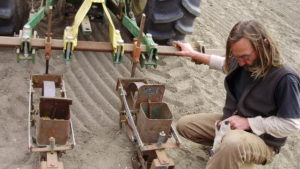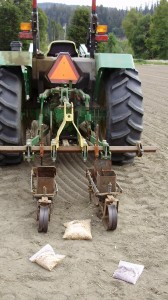
The weather was perfect for planting at Eel River Produce in Shively, CA this past Wednesday. The seedbed was prepared and the old Planet Juniors were calibrated to plant sweet corn. Bill Reynolds (right), owner of Eel River Produce, and Jared Zystro, OSA California Research and Education Specialist, set to work planting sweet corn for a new organic sweet corn breeding project.
The goal of this project, along with a similar sweet corn breeding effort in Minnesota, is to bring organic farmers a high quality open-pollinated sweet corn that can thrive in their organic systems. Both of these sweet corn projects are part of NOVIC, the Northern Organic Variety Improvement Collaborative, a four year effort to find and develop vegetable varieties for organic agriculture.
This year Jared and Bill will be self-pollinating and evaluating hundreds of ears from four different populations of corn to find those with promising genetics. They will be selecting plants for strong emergence and early vigor in cold soils, weed competitiveness, disease resistance, insect resistance and flavor.
 Participatory research like this leverages the strengths of both breeders and farmers. Breeders contribute expertise in topics such as crossing techniques, and farmers contribute their knowledge of the crop and their system. An example of this sort of collaboration was seen as Jared and Bill debated the seeding rate, with Bill insisting on a thick planting to allow for natural selection. Bill said, “There are other things out here besides us that will thin this corn. Crusted soils and wireworms will also do their own thinning.”
Participatory research like this leverages the strengths of both breeders and farmers. Breeders contribute expertise in topics such as crossing techniques, and farmers contribute their knowledge of the crop and their system. An example of this sort of collaboration was seen as Jared and Bill debated the seeding rate, with Bill insisting on a thick planting to allow for natural selection. Bill said, “There are other things out here besides us that will thin this corn. Crusted soils and wireworms will also do their own thinning.”
At the end of the day, Jared was enthusiastic about this project: “We would like to have an improved open pollinated sweet corn variety available to farmers within the next three or four years. Right now, the market is dominated by hybrid sweet corn varieties, which are expensive and cannot be saved and improved by farmers. And I know of no one breeding sweet corn specifically for organic farmers.”
